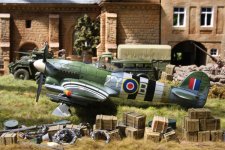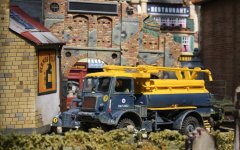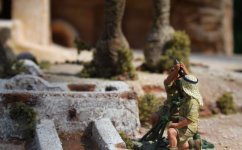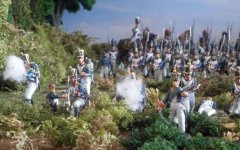You are using an out of date browser. It may not display this or other websites correctly.
You should upgrade or use an alternative browser.
You should upgrade or use an alternative browser.
Bored Tonight...Post a Diorama, LOL (1 Viewer)
- Thread starter desk11desk12
- Start date
Superb model and photograph, I'm lucky enough to have one in my collection.
Another cool set up with your ancient Egyptian models, I enjoy viewing the variety of scenes you present to us.Enough shade and water to share. Elements of the 1st Light Car Patrol stop at an oasis well for much needed water for themselves as well as their Model T's (also posted in the JJD and K&C sections)
Mike
View attachment 350876
mestell
Colonel
- Joined
- Feb 12, 2008
- Messages
- 8,804
Another cool set up with your ancient Egyptian models, I enjoy viewing the variety of scenes you present to us.
THX Brian, much appreciated.
Mike
panda1gen
Lieutenant Colonel
- Joined
- Jul 29, 2005
- Messages
- 7,334
mestell
Colonel
- Joined
- Feb 12, 2008
- Messages
- 8,804
Mike, I enjoy the way you set up your scenes too. All the best.
Fighting in the old town ......
View attachment 350901
Thank you very much Kevin. Your scenes are always well staged too.
Mike
Louis Badolato
Lieutenant General
- Joined
- Apr 25, 2005
- Messages
- 18,176
Maybe a Hawker Typhoon or a P47 Thunderbolt would alleviate some of that boredom ... lol
panda1gen
Lieutenant Colonel
- Joined
- Jul 29, 2005
- Messages
- 7,334
panda1gen
Lieutenant Colonel
- Joined
- Jul 29, 2005
- Messages
- 7,334
Ref: Wikipedia
Second Tactical Air Force (2TAF)
This was one of three tactical air forces within the Royal Air Force (RAF) during and after the Second World War. It was made up of squadrons and personnel from the RAF, other British Commonwealth air forces, and exiles from German-occupied Europe. Renamed as British Air Forces of Occupation in 1945, 2TAF was recreated in 1951 and became Royal Air Force Germany in 1959.
Formation
2TAF was formed on 1 June 1943 as HQ Tactical Air Force from Army Co-operation Command, in connection with preparations then in train to invade Europe a year later. It took units from both Fighter Command and Bomber Command in order to form a force capable of supporting the British Army in the field.
Bomber Command provided No. 2 Group equipped with light bombers.

Fighter Command was split, with the Air Defence of Great Britain, retaining fighter units for home defence.

No. 83 Group and No. 84 Group operated aircraft, whilst No. 85 Group controlled ground-based units, for the Second Tactical Air Force. In addition, No. 38 Group (for towing assault gliders) and No. 140 Squadron (who provided strategic photo-reconnaissance), were also part of the tactical air force at its inception.[3]
Second World War
2TAF's first commander was Air Marshal Sir John d'Albiac, who, on 21 January 1944, was succeeded by the man most associated with Second TAF, Air Marshal Sir Arthur Coningham.
Coningham had great experience of the type of operations required for supporting fast moving ground warfare due to his command of the Desert Air Force in North Africa and Italy. He honed Second TAF into a command up to the challenges presented to it, and incorporated many of the lessons from Italy, including the use of the "cab rank" system for aircraft for close air support, into the doctrine of Second TAF.
As soon as the armies advanced into Europe, 2nd TAF operated from forward airfields:

Second Tactical Air Force (2TAF)
This was one of three tactical air forces within the Royal Air Force (RAF) during and after the Second World War. It was made up of squadrons and personnel from the RAF, other British Commonwealth air forces, and exiles from German-occupied Europe. Renamed as British Air Forces of Occupation in 1945, 2TAF was recreated in 1951 and became Royal Air Force Germany in 1959.
Formation
2TAF was formed on 1 June 1943 as HQ Tactical Air Force from Army Co-operation Command, in connection with preparations then in train to invade Europe a year later. It took units from both Fighter Command and Bomber Command in order to form a force capable of supporting the British Army in the field.
Bomber Command provided No. 2 Group equipped with light bombers.

Fighter Command was split, with the Air Defence of Great Britain, retaining fighter units for home defence.

No. 83 Group and No. 84 Group operated aircraft, whilst No. 85 Group controlled ground-based units, for the Second Tactical Air Force. In addition, No. 38 Group (for towing assault gliders) and No. 140 Squadron (who provided strategic photo-reconnaissance), were also part of the tactical air force at its inception.[3]
Second World War
2TAF's first commander was Air Marshal Sir John d'Albiac, who, on 21 January 1944, was succeeded by the man most associated with Second TAF, Air Marshal Sir Arthur Coningham.
Coningham had great experience of the type of operations required for supporting fast moving ground warfare due to his command of the Desert Air Force in North Africa and Italy. He honed Second TAF into a command up to the challenges presented to it, and incorporated many of the lessons from Italy, including the use of the "cab rank" system for aircraft for close air support, into the doctrine of Second TAF.
As soon as the armies advanced into Europe, 2nd TAF operated from forward airfields:

Louis Badolato
Lieutenant General
- Joined
- Apr 25, 2005
- Messages
- 18,176
Kevin,Ref: Wikipedia
Second Tactical Air Force (2TAF)
This was one of three tactical air forces within the Royal Air Force (RAF) during and after the Second World War. It was made up of squadrons and personnel from the RAF, other British Commonwealth air forces, and exiles from German-occupied Europe. Renamed as British Air Forces of Occupation in 1945, 2TAF was recreated in 1951 and became Royal Air Force Germany in 1959.
Formation
2TAF was formed on 1 June 1943 as HQ Tactical Air Force from Army Co-operation Command, in connection with preparations then in train to invade Europe a year later. It took units from both Fighter Command and Bomber Command in order to form a force capable of supporting the British Army in the field.
Bomber Command provided No. 2 Group equipped with light bombers.
View attachment 351243
Fighter Command was split, with the Air Defence of Great Britain, retaining fighter units for home defence.
View attachment 351244
No. 83 Group and No. 84 Group operated aircraft, whilst No. 85 Group controlled ground-based units, for the Second Tactical Air Force. In addition, No. 38 Group (for towing assault gliders) and No. 140 Squadron (who provided strategic photo-reconnaissance), were also part of the tactical air force at its inception.[3]
Second World War
2TAF's first commander was Air Marshal Sir John d'Albiac, who, on 21 January 1944, was succeeded by the man most associated with Second TAF, Air Marshal Sir Arthur Coningham.
Coningham had great experience of the type of operations required for supporting fast moving ground warfare due to his command of the Desert Air Force in North Africa and Italy. He honed Second TAF into a command up to the challenges presented to it, and incorporated many of the lessons from Italy, including the use of the "cab rank" system for aircraft for close air support, into the doctrine of Second TAF.
As soon as the armies advanced into Europe, 2nd TAF operated from forward airfields:
View attachment 351245
The shots you took on the RAF Airfield you put together in my backyard are some of my favorites, along with the shots of the combined desert dioramas you took the same hot sunny afternoon!
panda1gen
Lieutenant Colonel
- Joined
- Jul 29, 2005
- Messages
- 7,334
Woodyskysolo
Corporal
- Joined
- Nov 17, 2021
- Messages
- 514
Absolutely fantastic scene Panda
panda1gen
Lieutenant Colonel
- Joined
- Jul 29, 2005
- Messages
- 7,334
Users who are viewing this thread
Total: 2 (members: 0, guests: 2)























